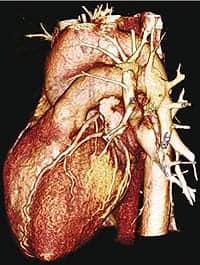 Julian G. Rosenman, MD, PhD Julian G. Rosenman, MD, PhD |
Radiation therapy seems to be a simple idea of lining the tumor up properly with the beam and delivering the prescribed radiation dose. How, though, do you know whether you treated all of the tumor and a minimum of normal tissue? Did the entire tumor receive the proper dose? The classic ways of obtaining the answers to these questions was to use port films or portal imaging, which were satisfactory in the days of large radiation fields. They are less satisfactory in the context of exquisitely shaped conformal fields or intensity-modulated radiation therapy (IMRT).
HITTING THE TUMOR
The radiation beam can miss the tumor for either of two reasons. First, the patient may not have been set up properly. Second, the internal organs may move, so that the target is not where it was expected to be. These problems need to be distinguished from each other, as they require different solutions.
Julian G. Rosenman, MD, PhD, a member of the Lineberger Comprehensive Cancer Center and Medical Image Display and Analysis Group, Chapel Hill, NC, is professor of radiation oncology and adjuvant professor of computer science at the University of North Carolina, Chapel Hill. He says, “There is no universally accepted definition of set up properly’. You could say that it means that every molecule of the patient is in the same position as when the patient was simulated, but not only can you not achieve this impossible feat, it would be impossible to prove that you had. A working definition is that the bones match the position in which the patient was simulated.” In the Lineberger Center’s experience, this confirmation requires imaging, using the Siemens PRIMATOM.
Proper positioning has two elements. One involves using tools such as laser marks and immobilization devices, but certain errors still seem to occur (as when the patient is twisted inside the immobilization cast). “If the radiation fields were large, this would not matter, but with highly conformal fields, a 1-cm error may be a disaster from the point of view of the treatment plan,” Rosenman says. Positioning the patient is not enough; repositioning, by moving the table or gantry, is also needed.
Several methods for directing repositioning are in use or being tested. The classic method is ultrasonography, which is not always of sufficient clarity and is not suitable for some types of lesions. A popular method for the treatment of prostate cancer is the implantation of radioactive seeds that are located using imaging before each session. Unfortunately, ultrasonography has three main drawbacks. First, it does not help in protecting the nearby normal organs because it does not indicate where they are. Second, tumor shrinkage and tissue edema will displace the seeds. Third, seed implantation is not suitable for most cancers.
Two potentially more accurate methods are being tested. One is the use of stereo paired radiographs: two radiographs are taken at a known fixed angle and compared with the planning CT scan. Several institutions are exploring this method, with which, as the PRIMATOM demonstrates, positioning errors of as little as a few millimeters can be detected with a high degree of accuracy. Another method, which is being investigated at the University of North Carolina, is photography. On the day of simulation, the patient is photographed by five fixed cameras. On the day of treatment, again, five pictures are taken for comparison with the first set. “You won’t get a perfect lineup, because people change from day to day, but we may be able to get a best fit,” Rosenman says. “You need to do more than eyeball the pictures. We need algorithms that will tell us precisely how the patient position is wrong.” The PRIMATOM is being used to verify the accuracy of this method.
DELIVERING RADIATION
The patient has been positioned and repositioned; this should mean that the organs are in their correct places. Can the operator turn on the radiation, confident that the desired dose will be delivered? This would be possible only if organs did not move. Some motion, like that of the prostate, is erratic and unpredictable. Other motion, like that of the lung, is more systematic. Different methods are needed to accommodate these two extremes.
Some radiation oncology departments attempt to immobilize the prostate. At the University of North Carolina, another approach has been selected, and it also is applicable to organs that cannot be immobilized. “If the patient is set up properly, we say, Go ahead and treat for a week,'” Rosenman explains. “Every day, you determine where the gland is using the PRIMATOM system, and at the end of the week, you calculate the dose that was actually delivered and construct a delivered dosevolume histogram (dDVH) for comparison with the planned dosevolume histogram (pDVH).”
Calculating the delivered dose is not as easy as it might sound.
“You can’t simply take the doses given each day and add them together,” Rosenman stresses. “You have to calculate them voxel by voxel. That is, the prostate is divided into thousands of tiny pieces, and each piece is located on each image; then the dose to each piece is calculated. Until recently, this type of analysis was not possible, but Sarang Joshi, ScD, of the Medical Imaging Display and Analysis Group has developed a warp registration method that allows you to take two images and calculate the most likely way to match them. 1 This analysis takes about an hour on a high-speed computer.”
The radiation oncology team then compares the dDVH with the pDVH. “If we see that some areas of the prostate are being overtreated or undertreated, we change the plan to compensate,” Rosenman explains. “We developed an optimizer that takes into account where the prostate is on all 5 weekdays. We generate a new treatment plan to steer us back toward our dosage goal. At the end of the second week, with 5 more days’ data, we determine whether we have corrected the problem. If we need a second big correction, we know that the motion of that patient’s prostate is really erratic, and we will need to get CT scans repeatedly because planning will never be ideal.” This technique, called adaptive radiation therapy, has been used in a few prostate cancer cases, to date.
The lung presents a different problem: periodic motion. There are four possible countermeasures. One already in use in a few centers is gating, in which the radiation beam is turned on only when the patient’s chest is in a particular position. Not only does gating not guarantee that the tumor target is in the same place, it is very time consuming to treat the patient that way. Another option is to obtain multiple three-dimensional (3D) CT or MRI scans to measure the extent of tumor motion and then to design the fields to accommodate it (see story “Improving Tumor Dose While Protecting Normal Tissue”). This is an updated version of a traditional method in which fluoroscopy was used. A third (and still experimental) approach is tomotherapy, in which the megavoltage radiation used for treatment is used to create helical CT scans, and the radiation beamlets are sequenced to compensate for tumor motion. An early report 2 on the use of this technique in lung cancer suggested that it is accurate for position verification and dose reconstruction if the tumor is in the pulmonary parenchyma, but suboptimal for mediastinal lesions.
Fourth, there is what Rosenman calls tracking, an experimental technique in which the multileaf collimator or table moves to keep the tumor in the center of the field and the strength of the beam (on constantly) is adjusted to take into account the amount of time that the tumor is not being exposed. The fifth method is called motion compensation through IMRT. “For example, part of the tumor might spend 10% of its time outside the radiation field, so when that piece of the tumor comes back into the field, the treatment plan greets it with a beam at 110%. This way, we do not have to know where the tumor is from moment to moment; we need to know only what percentage of the time it is in a particular position. This is called motion-compensated IMRT,” Rosenman says.
The approach also can incorporate protection of critical structures such as the esophagus and spinal cord. Tracking of lung tumors is now being refined using mechanical models. Because even a small tracking error could cause a large divergence between the planned and the delivered dose, the team believes it will be necessary to use adaptive radiation therapy as well, rescanning the patient about every 2 weeks and redesigning the plan.
FUTURE TREATMENT PLANNING
“What is going on here is fundamentally different from anything that we have done before,” Rosenman says. “In the past, the patient was scanned, the case was planned, and the cancer was treated. That is 3D treatment planning. You aim, you squeeze the trigger, and whatever happens, happens. What we are attempting is four-dimensional planning. 3 The patient is scanned repeatedly, and the results are fed back into the planning system, which modifies the treatment plan as appropriate. How this will work out, we don’t yet know. Probably, 5 years from now, some of it will be mainstream, and some of it will be forgotten. Only time will tell us which,” he concludes.
Judith Gunn Bronson, MS, is a contributing writer for Decisions in Axis Imaging News.
References:
- Joshi S, Pizer S, Fletcher PT, Yushkevich P, Thall A, Marron JS. Multiscale deformable model segmentation and statistical shape analysis using medial descriptions. IEEE Trans Med Imaging. 2002;21:538-550.
- Welsh JS, Bradley K, Ruchala KJ, et al. Megavoltage computed tomography imaging: a potential tool to guide and improve the delivery of thoracic radiation therapy. Clin Lung Cancer. 2004;5:303-306.
- Keall PJ, Joshi S, Tracton G, Kini V, Vedam S, Mohan R. 4-Dimensional radiotherapy planning. Int J Radiat Oncol Biol Phys. 2003;57:S233.





